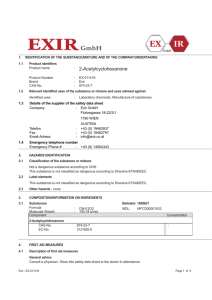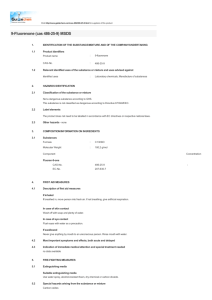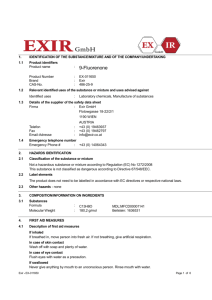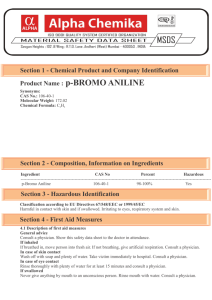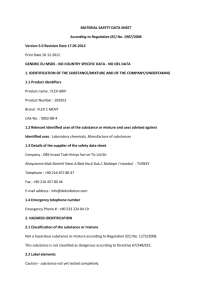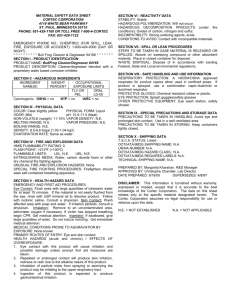msds 1-naphthaldehyde 97%
advertisement
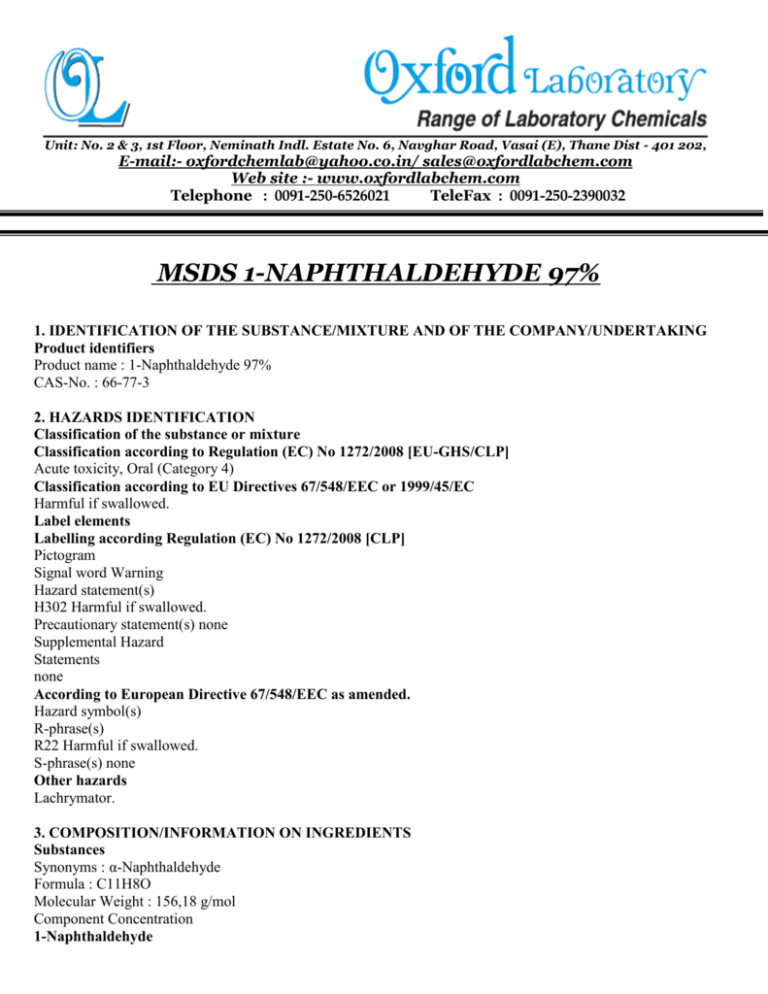
Unit: No. 2 & 3, 1st Floor, Neminath Indl. Estate No. 6, Navghar Road, Vasai (E), Thane Dist - 401 202, E-mail:- oxfordchemlab@yahoo.co.in/ sales@oxfordlabchem.com Web site :- www.oxfordlabchem.com Telephone : 0091-250-6526021 TeleFax : 0091-250-2390032 MSDS 1-NAPHTHALDEHYDE 97% 1. IDENTIFICATION OF THE SUBSTANCE/MIXTURE AND OF THE COMPANY/UNDERTAKING Product identifiers Product name : 1-Naphthaldehyde 97% CAS-No. : 66-77-3 2. HAZARDS IDENTIFICATION Classification of the substance or mixture Classification according to Regulation (EC) No 1272/2008 [EU-GHS/CLP] Acute toxicity, Oral (Category 4) Classification according to EU Directives 67/548/EEC or 1999/45/EC Harmful if swallowed. Label elements Labelling according Regulation (EC) No 1272/2008 [CLP] Pictogram Signal word Warning Hazard statement(s) H302 Harmful if swallowed. Precautionary statement(s) none Supplemental Hazard Statements none According to European Directive 67/548/EEC as amended. Hazard symbol(s) R-phrase(s) R22 Harmful if swallowed. S-phrase(s) none Other hazards Lachrymator. 3. COMPOSITION/INFORMATION ON INGREDIENTS Substances Synonyms : α-Naphthaldehyde Formula : C11H8O Molecular Weight : 156,18 g/mol Component Concentration 1-Naphthaldehyde CAS-No. 66-77-3 4. FIRST AID MEASURES Description of first aid measures General advice Consult a physician. Show this safety data sheet to the doctor in attendance. If inhaled If breathed in, move person into fresh air. If not breathing, give artificial respiration. Consult a physician. In case of skin contact Wash off with soap and plenty of water. Consult a physician. In case of eye contact Flush eyes with water as a precaution. If swallowed Never give anything by mouth to an unconscious person. Rinse mouth with water. Consult a physician. Most important symptoms and effects, both acute and delayed Cough, Shortness of breath, Headache, Nausea, Vomiting, To the best of our knowledge, the chemical, physical, and toxicological properties have not been thoroughly investigated. Indication of immediate medical attention and special treatment needed no data available 5. FIRE-FIGHTING MEASURES Extinguishing media Suitable extinguishing media Use water spray, alcohol-resistant foam, dry chemical or carbon dioxide. Special hazards arising from the substance or mixture Carbon oxides Precautions for fire-fighters Wear self contained breathing apparatus for fire fighting if necessary. Further information no data available 6. ACCIDENTAL RELEASE MEASURES Personal precautions, protective equipment and emergency procedures Use personal protective equipment. Avoid breathing vapors, mist or gas. Ensure adequate ventilation. Environmental precautions Do not let product enter drains. Methods and materials for containment and cleaning up Soak up with inert absorbent material and dispose of as hazardous waste. Keep in suitable, closed containers for disposal. Reference to other sections For disposal see section 13. 7. HANDLING AND STORAGE Precautions for safe handling Avoid contact with skin and eyes. Avoid inhalation of vapour or mist. Normal measures for preventive fire protection. Conditions for safe storage, including any incompatibilities Store in cool place. Keep container tightly closed in a dry and well-ventilated place. Containers which are opened must be carefully resealed and kept upright to prevent leakage. Specific end uses no data available 8. EXPOSURE CONTROLS/PERSONAL PROTECTION Control parameters Components with workplace control parameters Exposure controls Appropriate engineering controls Handle in accordance with good industrial hygiene and safety practice. Wash hands before breaks and at the end of workday. Personal protective equipment Eye/face protection Face shield and safety glasses Use equipment for eye protection tested and approved under appropriate government standards such as NIOSH (US) or EN 166(EU). Skin protection Handle with gloves. Gloves must be inspected prior to use. Use proper glove removal technique (without touching glove's outer surface) to avoid skin contact with this product. Dispose of contaminated gloves after use in accordance with applicable laws and good laboratory practices. Wash and dry hands. The selected protective gloves have to satisfy the specifications of EU Directive 89/686/EEC and the standard EN 374 derived from it. Body Protection Complete suit protecting against chemicals, The type of protective equipment must be selected according to the concentration and amount of the dangerous substance at the specific workplace. Respiratory protection Where risk assessment shows air-purifying respirators are appropriate use a full-face respirator with multi-purpose combination (US) or type ABEK (EN 14387) respirator cartridges as a backup to engineering controls. If the respirator is the sole means of protection, use a full-face supplied air respirator. Use respirators and components tested and approved under appropriate government standards such as NIOSH (US) or CEN (EU). 9. PHYSICAL AND CHEMICAL PROPERTIES Information on basic physical and chemical properties a) Appearance Form: clear, liquid Colour: dark yellow b) Odour no data available c) Odour Threshold no data available d) pH 7 at < 1 g/l at 20 °C e) Melting/freezing point Melting point/range: 1 - 2 °C - lit. f) Initial boiling point and boiling range 160 - 161 °C at 20 hPa - lit. g) Flash point 110 °C - closed cup h) Evaporation rate no data available i) Flammability (solid, gas) no data available j) Upper/lower flammability or explosive limits no data available k) Vapour pressure no data available l) Vapour density 5,39 - (Air = 1.0) m) Relative density 1,15 g/mL at 25 °C n) Water solubility no data available o) Partition coefficient: noctanol/water no data available p) Autoignition temperature no data available q) Decomposition temperature no data available r) Viscosity no data available s) Explosive properties no data available t) Oxidizing properties no data available Other safety information no data available 10. STABILITY AND REACTIVITY Reactivity no data available Chemical stability no data available Possibility of hazardous reactions no data available Conditions to avoid no data available Incompatible materials Strong oxidizing agents, Strong bases Hazardous decomposition products Other decomposition products - no data available 11. TOXICOLOGICAL INFORMATION Information on toxicological effects Acute toxicity LD50 Oral - rat - 667 mg/kg Remarks: Behavioral:Somnolence (general depressed activity). Behavioral:Muscle weakness. Skin and Appendages: Other: Hair. LD50 Dermal - guinea pig - > 22.900 mg/kg Remarks: Prolonged skin contact may cause skin irritation and/or dermatitis. Skin corrosion/irritation no data available Serious eye damage/eye irritation no data available Respiratory or skin sensitization no data available Germ cell mutagenicity no data available Carcinogenicity IARC: No component of this product present at levels greater than or equal to 0.1% is identified as probable, possible or confirmed human carcinogen by IARC. Reproductive toxicity no data available Specific target organ toxicity - single exposure no data available Specific target organ toxicity - repeated exposure no data available Aspiration hazard no data available Potential health effects Inhalation May be harmful if inhaled. May cause respiratory tract irritation. Ingestion Harmful if swallowed. Skin May be harmful if absorbed through skin. May cause skin irritation. Eyes May cause eye irritation. Signs and Symptoms of Exposure Cough, Shortness of breath, Headache, Nausea, Vomiting, To the best of our knowledge, the chemical, physical, and toxicological properties have not been thoroughly investigated. Additional Information RTECS: QJ0190000 12. ECOLOGICAL INFORMATION Toxicity no data available Persistence and degradability no data available Bioaccumulative potential no data available Mobility in soil no data available Results of PBT and vPvB assessment no data available Other adverse effects no data available 13. DISPOSAL CONSIDERATIONS Waste treatment methods Product Offer surplus and non-recyclable solutions to a licensed disposal company. Contact a licensed professional waste disposal service to dispose of this material. Contaminated packaging Dispose of as unused product. 14. TRANSPORT INFORMATION UN-Number ADR/RID: - IMDG: - IATA: 3334 UN proper shipping name ADR/RID: Not dangerous goods IMDG: Not dangerous goods IATA: Aviation regulated liquid, n.o.s. (1-Naphthaldehyde) Transport hazard class(es) ADR/RID: - IMDG: - IATA: 9 Packaging group ADR/RID: - IMDG: - IATA: Environmental hazards ADR/RID: no IMDG Marine pollutant: no IATA: no Special precautions for users no data available 15. REGULATORY INFORMATION This safety datasheet complies with the requirements of Regulation (EC) No. 1907/2006. Safety, health and environmental regulations/legislation specific for the substance or mixture no data available Chemical Safety Assessment no data available 16: Other Information References: Not available. Other Special Considerations: Not available. Disclaimer: ********************************************************************************************** The information contained herein in good faith but makes no representations as to its comprehensiveness or accuracy. This document is intended only as a guide to the appropriate precautionary handling of the material by a properly trained person using this product. Individuals receiving the information must exercise their independent judgment in determining its appropriateness for a particular purpose. Oxford laboratory makes no representations or warranties, either express or implied, including without limitation any warranties of merchantability, fitness for a particular purpose with respect to the information set forth herein or the product to which the information refers. Accordingly, Oxford Laboratory will not be responsible for damages resulting from use of or reliance upon this information.
